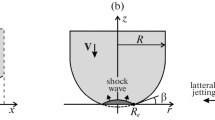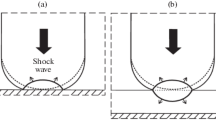Abstract
The high-speed liquid impact on a dry wall is known to result in appearance of a shock wave propagating up the impacting liquid from the wall. In the first stage this wave remains attached to the wall whereas in the second stage it detaches from the wall, leading to lateral jetting of the liquid compressed by the shock wave. In the first stage the pressure maximum on the wall, just like the extremes of other impact characteristics (the compressed liquid velocity, the shock wave slope, etc.), is attained at the shock wave edge. In the course of the first stage this maximum grows although in the second stage its magnitude gradually decreases. In the present work, the pressure maxima and the extremes of other compressed liquid characteristics achieved in the course of the first stages of liquid impact on a liquid surface and a wall wetted by a thin liquid film are studied, using known Heymann’s theory (J. Appl. Phys. 40, 1969) originally devoted to the liquid impact on a dry wall. Corresponding algebraic expressions for the compressed liquid characteristics at the impact area edge in the course of the first stage of liquid impact on a liquid surface and a wetted wall are derived. A variant with water as the involved liquids has been considered in detail. It is found that the impact characteristics in the case of impact on a liquid surface under the impact Mach number up to 1 are quite close to their values in the case of impact on a dry wall with half the impact angle and half the Mach number. In the case of a wall wetted with a very thin liquid film, the impact characteristics are close to those for a dry wall. It is shown that the derived expressions for the impact characteristics are useful for construction of the shock wave fronts during the first stage of liquid impact onto a liquid and a wetted wall.
















Similar content being viewed by others
REFERENCES
F. J. Heymann, ‘‘Erosion by liquids,’’ Mach. Des. 10, 118–124 (1970).
W. F. Adler, ‘‘The mechanics of liquid impact,’’ in Erosion, Ed. by C. M. Preece (Academic, New York, 1979), pp. 127–183.
M. E. Ibrahim and M. Medraj, ‘‘Water droplet erosion of wind turbine blades: Mechanics, testing, modeling and future perspectives,’’ Materials 13, 157-1–33 (2020).
J. Xiong, S. Koshizuka, and M. Sakai, ‘‘Numerical analysis of droplet impingement using the moving particle semi-implicit method,’’ J. Nucl. Sci. Technol. 47, 314–321 (2010).
K. Fujisawa, T. Yamagata, and N. Fujisawa, ‘‘Damping effect on impact pressure from liquid droplet impingement on wet wall,’’ Ann. Nucl. Energy 121, 260–268 (2018).
M. Kornfeld and L. Suvorov, ‘‘On the destructive action of cavitation,’’ J. Appl. Phys. 15, 495–506 (1944).
T. B. Benjamin and A. T. Ellis, ‘‘The collapse of cavitation bubbles and the pressures thereby produced against solid boundaries,’’ Phil. Trans. R. Soc. London, Ser. A 260 (1110), 221–240 (1966).
N. A. Hawker and Y. Ventikos, ‘‘Interaction of a strong shockwave with a gas bubble in a liquid medium: A numerical study,’’ J. Fluid Mech. 701, 59–97 (2012).
T. Trummler, S. Bryngelson, K. Schmidmayer, S. Schmidt, T. Colonius, and N. Adams, ‘‘Near-surface dynamics of a gas bubble collapsing above a crevice,’’ J. Fluid Mech. 899, A16 (2020).
M. B. Lesser and J. E. Field, ‘‘The impact of compressible liquids,’’ Ann. Rev. Fluid Mech. 15, 97–122 (1983).
W. Wu, Q. Liu, and B. Wang,‘‘Curved surface effect on high-speed droplet impingement,’’ J. Fluid Mech. 909, A7 (2021).
F. P. Bowden and J. E. Field, ‘‘The brittle fracture of solids by liquid impact, by solid impact and by shock,’’ Proc. R. Soc. London, Ser. A 282, 331–526 (1964).
J. H. Brunton, ‘‘High speed liquid impact,’’ Phil. Trans. R. Soc. London, Ser. A 260, 79–85 (1966).
M. C. Rochester and J. H. Brunton, ‘‘Surface pressure distribution during drop impingement,’’ in Proceedings of 4th International Conference on Rain Erosion and Associated Phenomena, Meersburg, Germany, Ed. by A. A. Fyall and R. B. King (R. Aircraft Establishm., Farnborough, UK, 1974), pp. 371–393.
J. E. Field, M. B. Lesser, and J. P. Dear, ‘‘Studies of two-dimensional liquid wedge impact and their relevance to liquid-drop impact problems,’’ Proc. R. Soc. London, Ser. A 401, 225–249 (1985).
N. K. Bourne, ‘‘On impacting liquid jets and drops onto polymethylmethacrylate targets,’’ Proc. R. Soc. London, Ser. A 461, 1129–1145 (2005).
F. J. Heymann, ‘‘High-speed impact between a liquid drop and a solid surface,’’ J. Appl. Phys. 40, 5113–5122 (1969).
M. B. Lesser, ‘‘Analytic solutions of liquid-drop impact problems,’’ Proc. R. Soc. London, Ser. A 377, 289–308 (1981).
A. A. Korobkin, ‘‘Asymptotic theory of liquid-solid impact,’’ Phil. Trans. R. Soc. London, Ser. A 355, 507–522 (1997).
K. K. Haller, Y. Ventikos, D. Poulikakos, and P. Monkewitz, ‘‘Computational study of high-speed liquid droplet impact,’’ J. Appl. Phys. 92, 2821–2828 (2002).
R. Li, H. Ninokata, and M. Mori, ‘‘A numerical study of impact force caused by liquid droplet impingement onto a rigid wall,’’ Prog. Nucl. Energy 53, 881–885 (2011).
T. Sanada, K. Ando, and T. A. Colonius, ‘‘A computational study of high-speed droplet impact,’’ Fluid Dyn. Mater. Process. 7, 329–340 (2011).
J.-B. G. Hwang and F. G. Hammitt, ‘‘High-speed impact between curved liquid surface and rigid flat surface,’’ J. Fluids Eng. 99, 396–404 (1977).
A. A. Aganin, M. A. Il’gamov, and T. S. Guseva, ‘‘Influence of the shape of the jet head on its impact on a wetted wall,’’ J. Appl. Mech. Tech. Phys. 60, 644–649 (2019).
F. Huang, Sh. Li, Y. Zhao, and Y. Liu, ‘‘Study on lateral jetting range during an arc-curved jet impacting nonplanar solid surfaces,’’ J. Fluids Eng. 140, 101201 (2018).
K. Fujisawa, T. Yamagata, and N. Fujisawa, ‘‘Liquid droplet impingement erosion on groove roughness,’’ Nucl. Eng. Des. 330, 368–376 (2018).
C. B. Burson-Thomas, R. Wellman, T. J. Harvey, and R. J. K. Wood, ‘‘Water droplet erosion of aeroengine fan blades: The importance of form,’’ Wear 426–427, 507–517 (2019).
J. E. Field, J.-J. Camus, M. Tinguely, D. Obreschkow, and M. Farhat, ‘‘Cavitation in impacted drops and jets and the effect on erosion damage thresholds,’’ Wear 290–291, 154–160 (2012).
T. Kondo and K. Ando, ‘‘One-way-coupling simulation of cavitation accompanied by high-speed droplet impact,’’ Phys. Fluids 28, 033303 (2016).
W. Wu, G. Xiang, and B. Wang, ‘‘On high-speed impingement of cylindrical droplets upon solid wall considering cavitation effects,’’ J. Fluid Mech. 857, 851–877 (2018).
W. Johnson and G. W. Vickers, ‘‘Transient stress distribution caused by water-jet impact,’’ J. Mech. Eng. Sci. 15, 302–310 (1973).
R. J. Hand, J. E. Field, and D. Townsend, ‘‘The use of liquid jets to simulate angled drop impact,’’ J. Appl. Phys. 70, 7111–7118 (1991).
A. V. Chizhov and A. A. Schmidt, ‘‘Impact of high-velocity drop on an obstacle,’’ Tech. Phys. 45, 1529–1537 (2000).
J. E. Field, J. P. Dear, and J. E. Ogren, ‘‘The effects of target compliance on liquid drop impact,’’ J. Appl. Phys. 65, 533–540 (1989).
P. A. Lush, ‘‘Impact of a liquid mass on a perfectly plastic solid,’’ J. Fluid Mech. 135, 373–387 (1983).
J. H. Brunton,‘‘Erosion by liquid shock,’’ in Proceedings of 2nd International Conference on Rain Erosion and Allied Phenomena, Meersburg, Germany, Ed. by A. A. Fyall and R. B. King (R. Aircraft Establishm., Farnborough, UK, 1967), pp. 535–560.
H. H. Shi, J. E. Field, and C. S. J. Pickles, ‘‘High speed liquid impact onto wetted solid surfaces,’’ J. Fluids Eng. 116, 345–348 (1994).
J. Xiong, S. Koshizuka, and M. Sakai, ‘‘Investigation of droplet impingement onto wet walls based on simulation using particle method,’’ J. Nucl. Sci. Technol. 48, 145–153 (2011).
H. Sasaki, N. Ochiai, and Y. Iga, ‘‘Numerical analysis of damping effect of liquid film on material in high speed liquid droplet impingement,’’ Int. J. Fluid Mach. Syst. 9, 57–65 (2016).
A. A. Aganin and T. S. Guseva, ‘‘Liquid jet impact on a wet wall,’’ Eur. J. Mech. B: Fluids 79, 141–150 (2020).
M. Marzbali and A. Dolatabadi, ‘‘High-speed droplet impingement on dry and wetted substrates,’’ Phys. Fluids 32, 112101 (2020).
J. M. Walsh, R. G. Shreffler, and F. J. Willig, ‘‘Limiting conditions for jet formation in high velocity collisions,’’ J. Appl. Phys. 24, 349–359 (1953).
F. J. Heymann, ‘‘On the shook wave velocity and impact pressure in high-speed liquid-solid impact,’’ J. Basic Eng. 90, 400–402 (1968).
G. Whitham, ‘‘A new approach to problems of shock dynamics. Part I: Two-dimensional problems,’’ J. Fluid Mech. 2, 145–171 (1957).
R. I. Nigmatulin and R. K. Bolotnova, ‘‘Wide-range equation of state of water and steam: Simplified form,’’ High Temp. 49, 303–306 (2011).
A. A. Aganin and T. S. Guseva, ‘‘Numerical simulation of liquid mass collision with a wall,’’ Progr. Comput. Fluid Dynam. Int. J. 19, 293–306 (2019).
K. Takizawa, T. Yabe, Y. Tsugawa, T. E. Tezduyar, and H. Mizoe, ‘‘Computation of free-surface flows and fluid-object interactions with the CIP method based on adaptive meshless Soroban grids,’’ Comput. Mech. 40, 167–183 (2007).
Funding
The present study was supported by the Russian Science Foundation (grant no. 21-11-00100). The author is thankful to Dr. T.S. Guseva for performing numerical calculations and helpful discussions.
Author information
Authors and Affiliations
Corresponding author
Additional information
(Submitted by A. M. Elizarov)
Rights and permissions
About this article
Cite this article
Aganin, A.A. High-speed Liquid Impact on a Liquid Surface and a Wetted Wall. Lobachevskii J Math 43, 2029–2045 (2022). https://doi.org/10.1134/S1995080222110038
Received:
Revised:
Accepted:
Published:
Issue Date:
DOI: https://doi.org/10.1134/S1995080222110038




